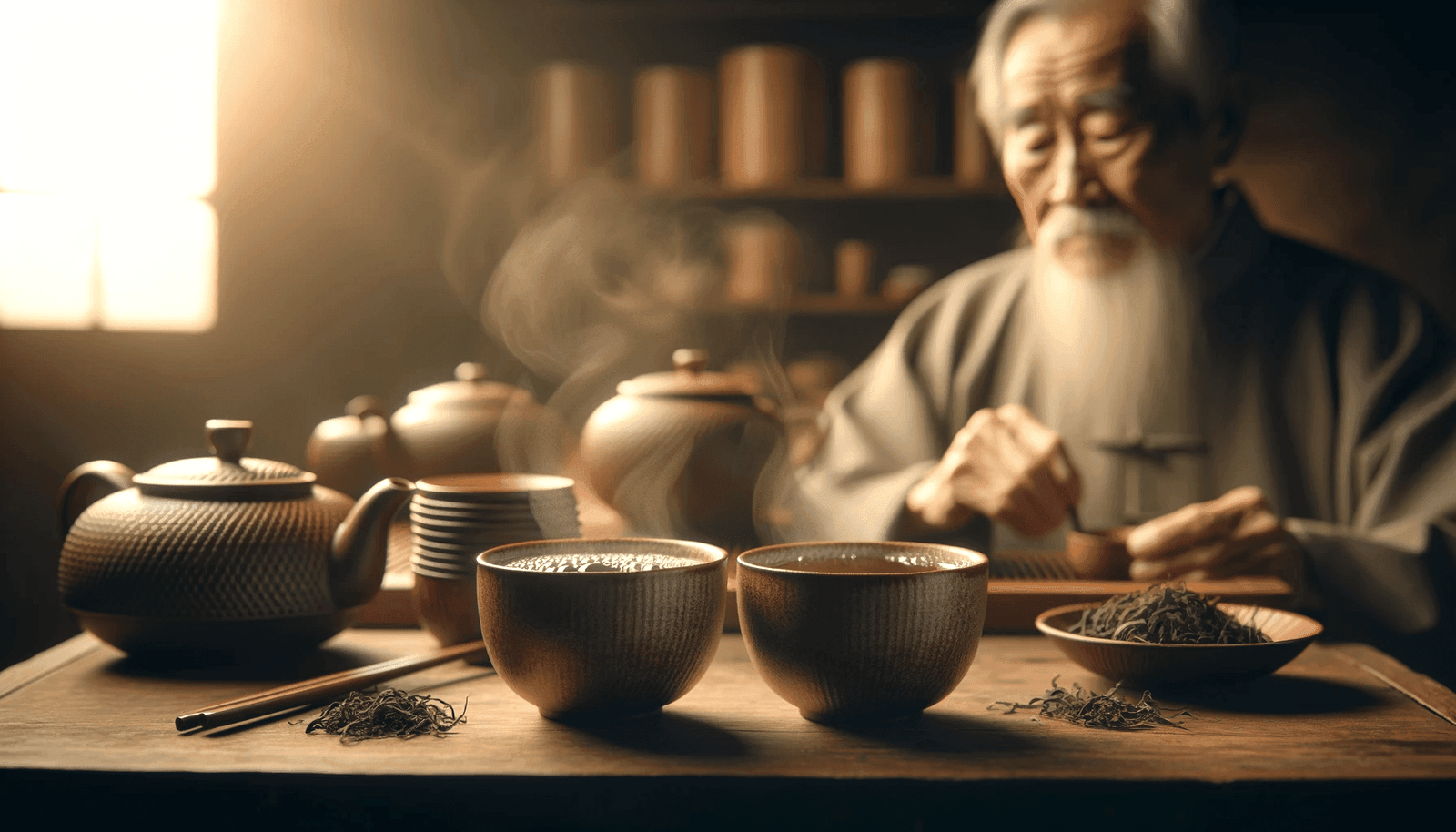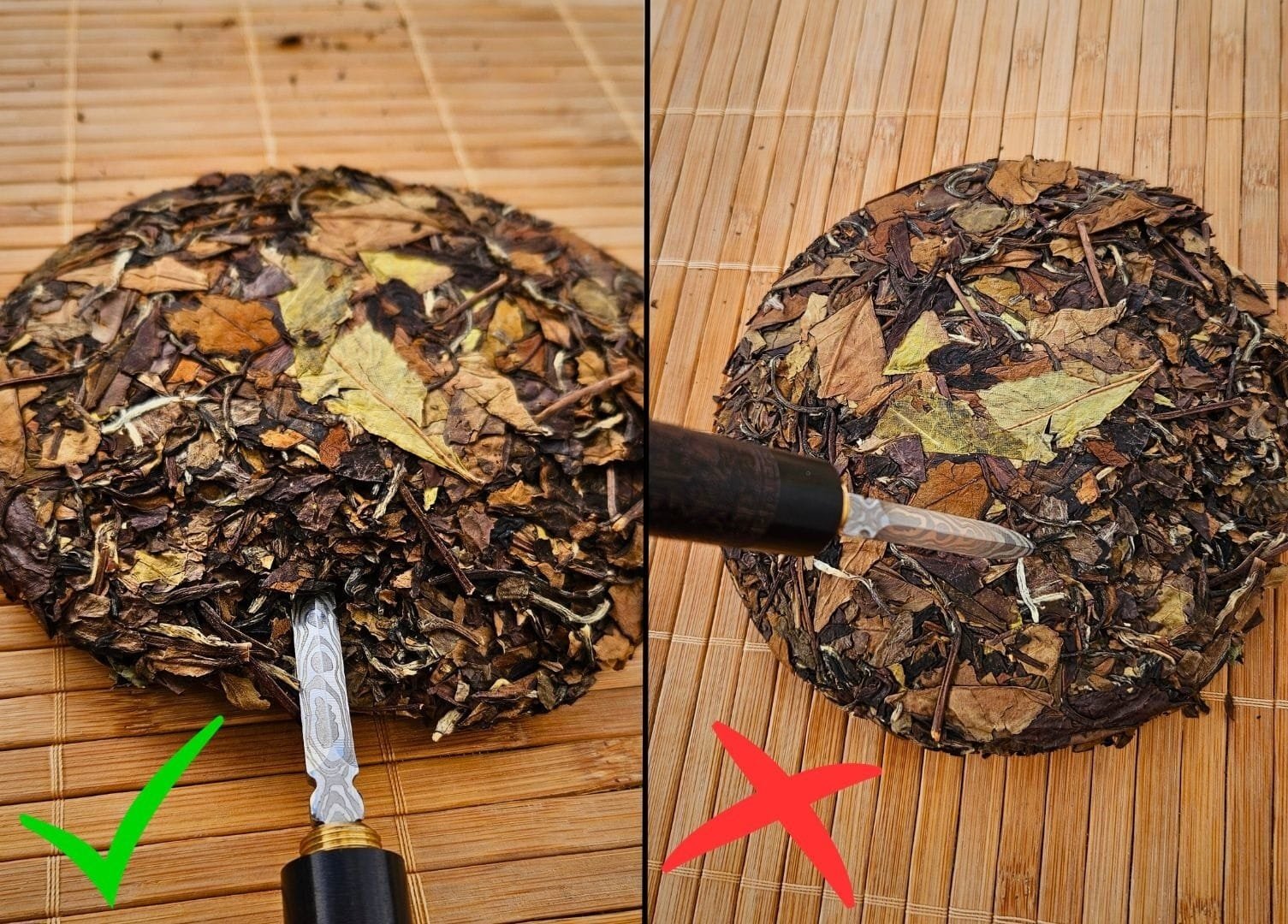Brewing White Tea is a pleasure for the senses. A journey through delicate aromas that develop with every infusion. And the great thing about it: White tea is not only a real treat, but also extremely beneficial for your health.
In this article, you will learn how to brew loose leaf white tea: brewing time, temperature and quantity for the perfect cup. I will show you two different preparation methods: a quick and uncomplicated method and the traditional Chinese way. Plus you’ll get some expert tips for tasting white tea, that will elevate your enjoyment to the next level. Grab a cup and let’s go!

Inhalt
ToggleWhat is White Tea?
White tea, popular for its delicate elegance of taste, has its origins in the renowned tea regions of China. Only tea that comes from the young, tender leaves and buds of the Camellia Sinensis tea plant deserves the name “white tea”. Not only white tea, but also all other types of classic tea are made from this plant: Green tea, black tea, Yellow tea, Pu Erh and Oolong. The unique taste and health benefits of white tea are the result of careful processing and its minimal degree of oxidation. Of all tea varieties, white tea undergoes the fewest processing steps and thus retains most of its valuable ingredients. After harvesting, the tea leaves are left to wither naturally in the sun. They are then gently dried.
Among the white teas, there are different varieties that differ from each other in their production and taste. For beginners, I often recommend Bai Hao Yin Zhen, also known as “Silver Needle”, which is famous for its fine and refreshing taste. In another article I have summarized recommendations for high-quality varieties of white tea and show you how to recognize quality.

- Guaranteed Quality and Freshness
- Secure Payment
- Fast Shipping
Tobias
How to Brew Loose Leaf White Tea
The best way to prepare white tea and enjoy the drink is to prepare the tea carefully and consciously. The traditional Chinese “Gong Fu” method emphasizes the careful preparation of the tea, paying close attention to every detail from the water temperature to the brewing time. The aim is to bring out the optimum effect and taste of the tea.
Although the Gong Fu style is deeply rooted in the Chinese tea tradition, the Western style offers a practicable alternative. With this method of preparation, fewer tea leaves are used. In return, the infusion time is increased. This method extracts all the aromas of the tea at once, which is why individual nuances of taste are lost.
In addition to the simpler Western style method, however, I recommend that you try the traditional method. With this method in particular, white teas develop new nuances of flavor with every infusion. With less water and more tea leaves, the infusion time is shortened so that you can enjoy a greater number of infusions, each of which brings out different flavor facets of the tea.

White Tea: Temperature
In contrast to Black tea or Oolong, you can also use lower water temperatures for white tea. You can use the following rule as a guide: If your white tea is made from leaves (e.g. White Peony), you can use 70 – 85 C (158 – 185 ℉) . At these temperatures, sweet, delicate flavors will emerge. If you start at 158 ℉, you can also increase the temperature by 10 – 15°C (50 – 59 ℉) for the 2nd and 3rd infusion. If your white tea consists of leaf buds (e.g. Yin Zhen / Silver Needle or Ya Bao), on the other hand, you can start with a temperature of 90°C (194 ℉). Here too, you can increase the temperature for further infusions.
Tip: It is very helpful to have a kettle where you can set the temperature. If you don’t have a kettle that allows you to adjust the temperature, you can use the following trick to directly reach the ideal temperature for white tea: If you add one-third room temperature water to two-thirds boiling water, the water will have an approximate final temperature of 70°C (158 ℉).
White tea: Brewing time
White tea is well suited for beginners, as it does not become bitter even if brewed for too long. However, white teas often develop Astringency, when steeped for too long. This is a dry, slightly furry sensation on the tongue. Astringency is not necessarily negative and, when well balanced, can contribute to the complexity and depth of a tea’s flavor profile.
You will usually find information on the brewing time on the packaging of your tea. You can use this as a guide. However, they usually refer to the western way of preparing tea, where longer infusion times are used. This usually only gives you 3 infusions, whereas you can achieve between 5 and 8 infusions with a shorter infusion time and more tea leaves.
There is no right or wrong way to make tea. You can experiment with the brewing time and temperature of your white tea to find the ideal taste.
Simple method for brewing white tea (Western style)
– Take about 2-3 grams of tea (1-2 tsp) and pour it into a pot.
– Pour 250 ml (8,5 oz) of water at 70 – 90 °C (158 – 194 ℉) over the leaves.
– Leave the tea to infuse for 2-3 minutes.
– You can make 2-3 infusions, increasing the infusion time by one minute each time.
The best way to prepare white tea (Gong Fu)
– It’s best to use a clay pot or a porcelain gaiwan. But they can both be expensive or hard to handle. A great easy and cheap option for beginners are glass pots.
– Take 4-5 grams (3-4 tsp) of tea leaves per 150 ml (5 oz) of water.
– Heat the water to 70 – 90 °C (158 – 194 ℉)
– Preheat the empty pot by leaving hot water inside for a short while.
– Put the tea leaves in the pot. The first infusion only serves to “wash” and open the leaves. You only leave the water in the pot for about 5 seconds and pour the first infusion away.
– For the first proper infusion, leave the tea to infuse for 25-30 seconds.
– When pouring, make sure to distribute the tea evenly between the cups. Fill the cups alternately to ensure an even flavor intensity. Alternatively, you can pour the tea into a decanter (also known as a gong da bei) first.
– Enjoy your delicious drink and repeat the process until the leaves no longer give off any flavor. High-quality white tea allows at least five infusions, often even more.
– Extend the infusion time by 5-10 seconds for each additional infusion.
Choosing the Right Water
As water makes up 99% of the finished beverage, its quality plays a crucial role in the taste of your white tea. Soft, low-mineral water is best for enhancing the subtle flavors of the tea. Fresh water with a high oxygen content is ideal. The water loses oxygen every time it is boiled.
For optimal taste, I recommend using a water filter or bottled mineral water, especially if the tap water in your area is very calcareous. Among the mineral waters in Germany, Volvic has the best properties for tea.
Pressed White Tea Cakes: How to Remove the Tea Leaves
At this point, we will make a small digression. If you delve a little deeper into the world of white teas, sooner or later you will come across aged white teas. These exquisite teas are stored for years and develop an incredible variety of flavors. The leaves are often pressed into a cake or block form for storage. The correct handling of the tea cake is crucial in order to preserve the quality and aroma of the teas. If the leaves break, the tea infusion often becomes bitter and the individual flavors are extracted too quickly. So how do you remove the required amount of leaves?
Special tools, such as a tea knife or tea needle, are recommended for removing the tea leaves from these compact cakes. Investing in such a tool can make handling the tea cakes much easier. If you don’t have a special tea tool to hand, a fine kitchen knife or a small fork can also be helpful.
When separating the required amount of tea leaves from a tea cake, it is advisable to start at the outer edges, as the tea is usually less tightly pressed there. Look closely at the tea cake to see the layering of the leaves. Carefully place the tool between the layers and gently lift the leaves to loosen them. Be careful not to pierce the cake vertically to avoid breaking the leaves

Tasting Tips
The traditional gong fu preparation of white tea also involves consciously savoring the tea. Hold the tea in your mouth for a few seconds and pay attention to the different flavors. Can you taste flowers, fruit or nuts? Perhaps the tea reminds you of fresh, clean morning air or fresh grass? Personally, white tea often reminds me of the taste of raw cookie dough, which is often accompanied by a lingering sweetness. Try to pause for a moment and take in the flavors that unfold in your mouth.
Another tip for a more intense taste is retro-nasal tasting: Exhale through your nose while you have the tea in your mouth to heighten your taste sensation and discover new nuances.
It is exciting to watch the flavor develop with each infusion. Smell the warm leaves after pouring and enjoy their wonderful fragrance.
After a few infusions, you will probably notice a pleasant effect on your body. White teas often offer a relaxing effect that can range from a slight sense of relaxation to a stimulating energy. Tea contains the amino acid L-theanine, which has a calming effect and can positively influence brain function. Theanine promotes relaxation without drowsiness and can also support dopamine production.
Storage of White Tea
Storing white tea correctly is very important for preserving its quality and taste. It is best to store it in a cool, dark and dry place. Usually you can leave the tea in its original packaging.
It is important to protect the tea from external odors, as tea can quickly take on foreign smells. This is why the kitchen is often not the best place to store tea, especially if the tea packaging is not well sealed. Under the right conditions, white tea can be stored for many years.
Summary
White tea unfolds an impressive taste experience that always delights even beginners. White tea also offers a wealth of health benefits. There is little you can do wrong when preparing white tea, so you can experiment with brewing time and temperature to your heart’s content.
In order to experience the full spectrum of its aromas, it is important to prepare and taste the white tea carefully. Traditional gong fu preparation is particularly beneficial. It allows you to create a variety of infusions and enjoy the tea to the full throughout the day.
If you are still undecided about which type of white tea to buy, then I recommend Ya Bao and Pai Mu Tan (White Peony). In this article you will learn more about the different types of white tea and how to find high quality teas that suit your taste.
A fascinating and exquisite alternative to white tea is offered by Yellow Tea. This mysterious and rare tea is characterized by a similar taste structure to white tea, complemented by a unique and distinctive note.
Frequently Asked Questions
White tea should steep for between 1 and 5 minutes, depending on the variety and personal preference. According to the traditional Gong Fu method, white tea only steeps for a few seconds.
In general, you can drink 3-4 cups of white tea a day. As it contains caffeine, people with caffeine sensitivity should adjust their intake accordingly.
Depending on the variety, white tea can contain high amounts of caffeine. People who are sensitive to caffeine should therefore no longer drink it in the evening.
High-quality white tea can be infused at least 2-3 times, with each infusion releasing unique flavors. Very good white teas even yield up to 10 infusions.
If white tea is steeped for too long, it can become bitter and lose its fine, delicate aromas. It is therefore advisable to monitor the infusion time to get the best taste.
White tea is prepared by brewing the leaves with hot water (approx. 70-90°C) and leaving them to infuse for 1-5 minutes. The quantity of leaves and the infusion time can be adjusted to vary the taste according to personal preference.

